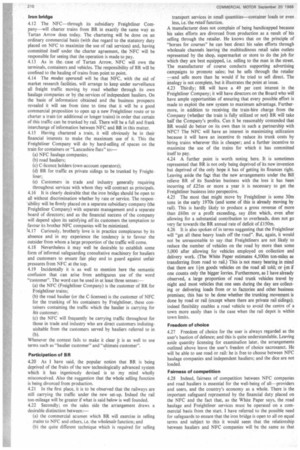Iron bridge 4.12 The NEC—through its subsidiary Freightliner Company—will charter
Page 214

If you've noticed an error in this article please click here to report it so we can fix it.
trains from BR in exactly the same way as Tartan Arrow does today. The chartering will be done on an ordinary commercial basis (with due regard to the statutory duty placed on NFC to maximize the use of rail services) and, having committed itself under the charter agreement, the NFC will be responsible for seeing that the operation is made to pay.
4.13 As in the case of Tartan Arrow, NEC will own the terminals, containers and vehicles. The responsibility of BR will be confined to the hauling of trains from point to point.
4.14 The modus operandi will be that NFC, with the aid of market research facilities, will arrange to keep under surveillance all freight traffic moving by road whether through its own haulage companies or by the services of independent hauliers. On the basis of information obtained and the business prospects revealed it will see from time to time that it will be a good commercial proposition to open up a new Freightliner route or to charter a train (or additional or longer trains) in order that certain of this traffic can be trunked by rail. There will be a full and frank interchange of information between NFC arid BR in this matter. 4A5 Having chartered a train, it will obviously be in their financial interests to make the maximum use of it. This the Freightliner Company will do by hard-selling of spaces on the train for containers or "Lancashire flats" to:—
(a) NFC haulage companies; (b) road hauliers; (c) C-licence holders (own-account operators); (d) BR for traffic ex private sidings to be trunked by Freightliner; (e) Customers in trade and industry generally requiring throughout services with whom they will contract as principals. 4.16 It is clearly desirable that the iron bridge should be open to all without discrimination whether by rate or service. The respon'sibility will be firmly placed on a separate subsidiary company (the Freightliner Company) with separate management and a separate board of directors; and as the financial success of the company will depend ufaon its satisfying all its customers the temptation to favour its brother NFC companies will be minimized. 4.17 Curiously, brotherly love is in practice conspicuous by its absence and in my experience the tendency is to favour the outsider from whom a large proportion of the traffic will come. 4.18 Nevertheless it may well be desirable to establish some form of informal safeguarding consultative machinery for hauliers and customers to ensure fair play and to guard against unfair pressures from NFC at the top.
4.19 Incidentally it is as well to mention here the semantic confusion that can arise from ambiguous use of the word "customer". The word can be used mat least three senses:— (a) the NFC (Freightliner Company) is the customer of BR for Freightliner trains; (b) the road haulier (or the C-licensee) is the customer of NFC for the trunking of his containers by Freightliner, these containers containing the traffic which the haulier is carrying for his customer; (c) the NEC will frequently be carrying traffic throughout for those in trade and industry who are direct customers indistinguishable from the customers served by hauliers referred to in (b).
Whenever the context fails to make it clear it is as well to use terms such as "haulier customer" and "ultimate customer".


















































































































































































































































































































































































